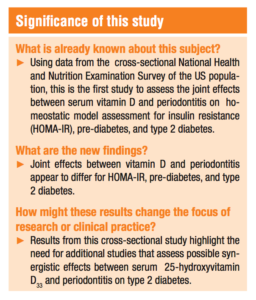
In her new paper, anchored in a national health and nutrition examination survey, our Pop Health Analytics team member and doctoral candidate Aleksandra Zuk, alongside Drs. Carlos R Quiñonez, Olli Saarela, Ryan Demmer, and Laura Rosella, analyzed the joint effects of serum vitamin D insufficiency and periodontitis on insulin resistance, pre-diabetes, and type 2 diabetes.
Periodontitis
Periodontitis (a chronic infection that causes inflammation of the tissue surrounding the teeth) is strongly associated with diabetes and is increasingly shown to be associated with other glycemic abnormalities (irregular concentrations of sugar or glucose in blood). Vitamin D is not only important for bone health but has also been shown to have both anti-inflammatory and antimicrobial effects.
Zuk et al. investigated the joint effects of both serum 25-hydroxyvitamin D3 (vitamin D3) and total 25-hydroxyvitamin D (total vitamin D) with periodontitis on (i) insulin resistance measured by the homeostatic model assessment of insulin resistance (HOMA-IR), (ii) prediabetes, and (iii) type 2 diabetes.
Survey Analysis
By using data from the 2009–2010 National Health and Nutrition Examination Survey, researchers gathered a sample of adults both with (1,631 individuals) and without (1,369 individuals) type 2 diabetes. From this sample, they examined the following joint effects among adults over 30 years of age:
1) vitamin D3 insufficiency [25(OH)D3 < 50 nmol/L] and moderate-to-severe periodontitis;
2) vitamin D3 insufficiency and mild-to-no periodontitis;
3) vitamin D3 sufficiency [25(OH)D3 ≥ 50 nmol/L] and moderate-to-severe periodontitis.
These joint effects were compared to a doubly unexposed group. To accommodate NHANES’ complex sample design, survey logistic multivariable regression models assessed joint effects of vitamin D3 (and total vitamin D) insufficiency with periodontitis on three outcomes (i.e., HOMA-IR ≥4.17, prediabetes, and type 2 diabetes).
The Findings
The findings of this cross-sectional study showed significant joint effects between periodontitis and both vitamin D metabolites (i.e., vitamin D3 and vitamin D insufficiency) on type 2 diabetes. The researchers also found significant positive additive interaction indicating that vitamin D3 insufficiency and periodontitis are greater than the sum of the individual effects. Insulin resistance measured by HOMA-IR or prediabetes, on the other hand, yielded no significant association with either joint effects.
Understanding how two common exposures like vitamin D insufficiency and periodontitis work together on glycemic outcomes–particularly type 2 diabetes–addresses an important research gap.
To read the full study, click here.
